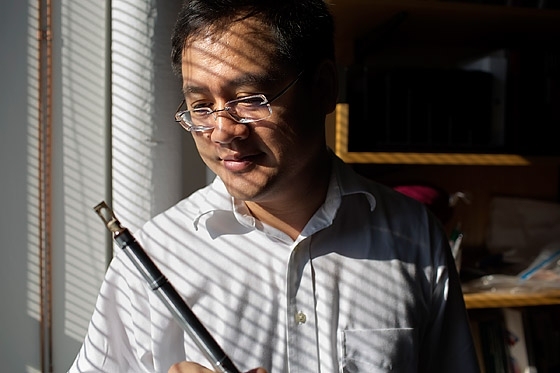Growing up in China as the son of two engineers, Ju Li says he was initially more interested in pure science than in hands-on engineering. “I was pretty fascinated by theoretical physics when I was a kid,” he recalls.
But in the end, he found a way to combine the theoretical with the practical: studying how atoms and electrons behave and interact in a way that allows him to design new materials from the atomic level on up.
Li, who holds a joint appointment as a professor in MIT’s departments of materials science and engineering (DMSE) and nuclear science and engineering (NSE), has ended up in a field of research that could transform the way energy is generated, stored and used — in everything from batteries tinier than mitochondria to huge nuclear powerplants.
In his college years at the University of Science and Technology of China, Li became very interested in electrical engineering and computer science, he explains. That led him to an approach that uses computer simulations of materials at the electronic and atomic levels to understand the potential for new ways of using these materials — techniques that can then be confirmed and developed through precise laboratory experiments.
Working across a wide range of scales has been a central feature of Li’s research ever since he arrived at MIT as a doctoral student. “I found I could use my knowledge of physics, and work with computers” to model the behavior of materials. “I felt it was a very good fit,” he says.

After earning his PhD in nuclear engineering from MIT in 2000, he spent two years as a postdoc here, working with Sidney Yip, now professor emeritus, who also holds a joint appointment in NSE and DMSE. During that time Li also worked with MIT researchers Subra Suresh, who is now director of the National Science Foundation, and Krystyn Van Vliet, an associate professor in DMSE.
He left MIT in 2002 to take an assistant professor position in materials science and engineering at Ohio State University, moving to the University of Pennsylvania in 2007 as an associate professor of materials science. He returned to MIT in 2011 as the Battelle Energy Alliance Professor of Nuclear Science and Engineering and as a professor in DMSE. His wife, a biological engineer, is currently a postdoc at MIT; the couple has a 12-year-old daughter and a 5-year-old son.
Li is involved in observing and simulating the dynamical behavior of the tiniest structures, helping design nanoscale wires — just tens of nanometers thick — that could act as anodes and cathodes, the two active poles of a battery, but on a scale far smaller than anyone has produced before. With some further work to integrate these into a working device, he says, this could be a first step toward a real-life version of a system that could approach the amazing capabilities shown in the 1966 sci-fi film “Fantastic Voyage,” which depicted a miniaturized submarine that could navigate through a person’s bloodstream in order to remove a blood clot.
“With our collaborators, we have made the smallest battery in the world,” Li says. Though it is not yet fully developed — his group still needs to find ways of packaging these electrodes into a complete, functional unit — the miniaturized battery could someday provide a power source for micro- and nanodevice mobility, Li says.
Taking advantage of sophisticated in situ transmission electron microscopy (TEM), he has also discovered several new phenomena that take place at these tiny scales and which could someday be harnessed. “Seeing is believing,” Li says of the in situ TEM validation. “It provides a very good check of our new methods of modeling.”
Most analysis of these dynamics at the atomic scale, Li says, is too limited to find their really significant effects, because of the daunting amount of computational power needed to carry out long-term simulations. “What are important for materials over time are rare events, where bonds break and a dislocation or a crack can evolve,” he says. Li and his colleagues have found ways around this by developing algorithms that can overcome timescale limitations and predict such “rare” events that drive microstructure evolution.
By applying an accelerated simulation technique, Li was able to use these new models to extrapolate from timescales of a few nanoseconds up to centuries or millennia — the time needed to evaluate the stability of containers used to store the waste from nuclear reactor cores, which can remain dangerously radioactive for many thousands of years.
Now, Li says, some of his new work is focused on how large elastic strain affects the properties of materials. For example, Intel and other companies have found that when silicon is stretched so that its lattice expands by about 1 percent, the ability of electrons to move within the material increases by about 50 percent; this technique is already being applied to a wide range of electronic chips. Li thinks this is just scratching the surface of what could become a vast array of applications based on elastic strain engineering.
By going down to nanoscale manipulations of large elastic strain, Li says, he thinks it will be possible to discover new and unanticipated properties of materials. He thinks the impact on future engineering could be comparable to the invention of alloying of metals by our ancestors, which ushered in the Bronze Age more than five millennia ago. New technologies for making nanomaterials that can withstand large stress without relaxation, and for applying and measuring elastic strain and understanding its effects on physical and chemical properties, are opening up revolutionary new possibilities for engineered materials, he says.
“I believe this may eventually have an impact on human civilization as much as chemical alloying has had,” Li says. “Nanomaterials generally have much larger tolerance for elastic strain. By exploring materials in the six-dimensional elastic strain space, we try to impart a new meaning to Feynman’s statement that there’s plenty of room at the bottom.”






